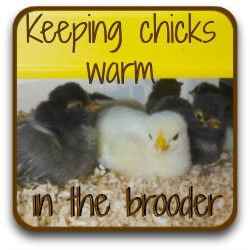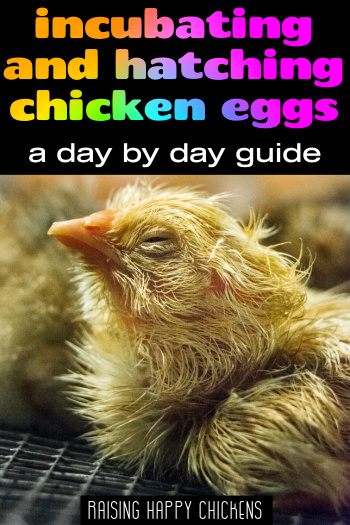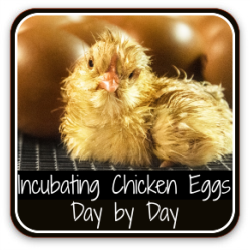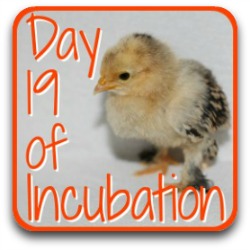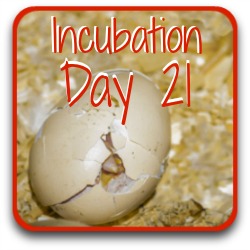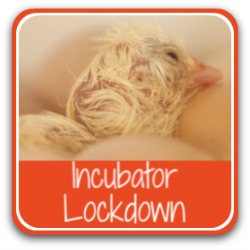- Home
- Incubation day by day
- Day 20
How to hatch chicken eggs: day 20 in the incubator.
The last but one stage of incubation is a time of massive change as our chick prepares to breathe for itself. It's an exciting – and sometimes worrying – time!
It's very important to remember that not all chicks hatch at day 21. I've had some which have not felt the need to come out of their egg until day 26.
Although there are common developments, incubating and hatching is not an exact science. Don't start panicking if your chicks don't hatch tomorrow – or even if they start to "unzip" today!

What's going on in the egg today?
- The chick is getting ready to hatch.
- The chick is getting larger and the yolk sac smaller. That's because the yolk is now about halfway inside the chick's body. It needs to be completely enclosed before the chick can safely hatch.
- As the yolk decreases during today the chick fills the shell completely, apart from the large air cell.
What's happening to the chick at day 20?
- Most of the processes which have been developing during previous stages of incubation are now complete.
- The chick is covered in down; its skeleton, legs and wings are well formed and hardened, and the intestines are almost completely absorbed into the body.
- The chick's head turns further towards the air cell where it will soon break through to start breathing on its own.
Please note: the image below is a commissioned piece and is subject to international copyright laws. I am the sole copyright owner.
It must not be used, copied or reproduced anywhere without my permission.
Contact me for details and permissions for this and all other images on this page.
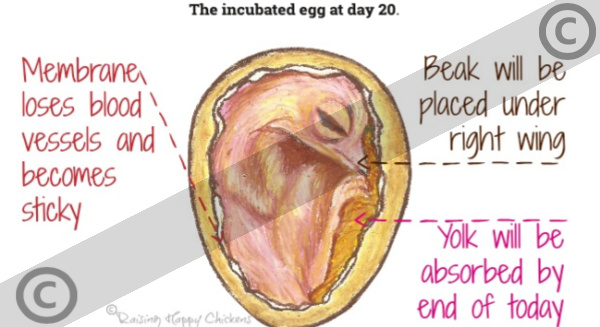
- The chorioallantoic membrane, which the chick has been using to breathe in oxygen and breathe out carbon dioxide, is now starting to lose importance as the chick will soon start using its lungs to breathe for the first time.
- The membrane's blood vessels decrease as they are absorbed into the chick's body, and the membrane itself becomes quite sticky.
- It's this membrane the raised incubator humidity is keeping moist during the final stages of incubation and throughout hatching. If it dries out, it will harden and potentially "shrink wrap" the chick, who won't be able to 'pip' its way through.
Candling eggs, day 20: don't do it!
It's important that the eggs are not candled today.
We're very close to hatch. The eggs should remain still on the incubator floor, and the incubator lid should remain closed to preserve the humidity the membrane needs to keep moist.
As the moisture levels begin to build for hatch, you'll probably start to see some water droplets on the inside of the incubator. Don't worry – it's not a problem and will help to ensure the humidity in the incubator remains high.
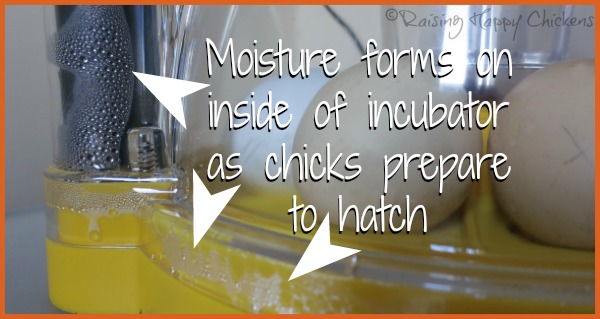
How to hatch chicken eggs: what should we be doing today?
Most importantly, leave the eggs alone – they know what they're doing!
Stop watching those eggs obsessively (I know you are, I've been there!) and start planning ahead.
Yesterday, we looked at what just-hatched chicks need, and dealt with brooder issues.
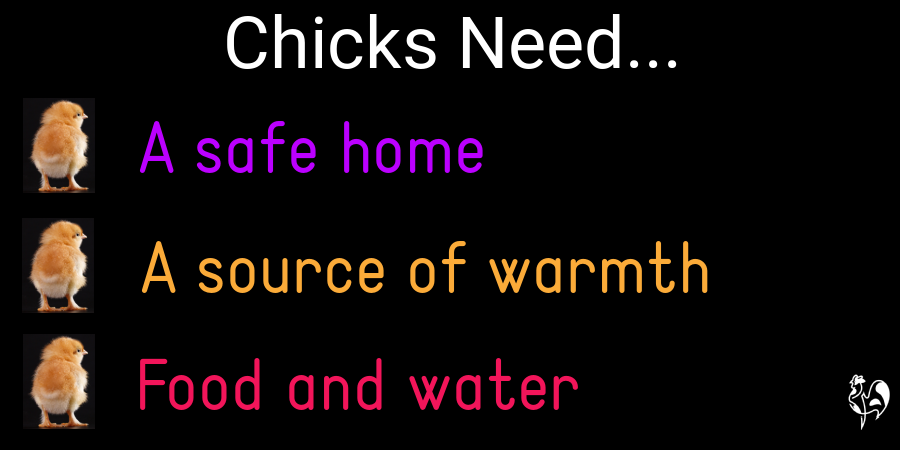
How to keep chicks warm in the brooder.
Today, let's make sure our chicks will be warm enough post-hatch.
Chicks are easily chilled after moving from incubator to brooder. They need enough heat to keep them warm, but not so much that it overheats and then kills them.
The articles below explain how to safely warm the brooder for your newly-hatched chicks.
Can anything go wrong at this late stage of incubation?
The main thing that goes wrong today and tomorrow is that we become too anxious about what's going on – or not going on – and try to "help".
Many full-term chicks have been killed by well-meaning owners trying to assist them out of the egg too early.
Although chicken embryos go through definite stages of development, the speed with which they go through incubation varies and can be affected by environmental issues like the temperature and humidity levels.
So although on average hatch day will be 21 days after setting the eggs, it's not unusual for it to take longer. I've had perfectly healthy chicks hatch between days 24 and 26.
I know it's an anxious time but trust that everything will be fine.
Relax!
How to hatch chicken eggs: question of the day.
It's day 20 and I'm not seeing any signs of 'pipping'. Should I make a hole for the chick to breathe?
Absolutely, definitely, categorically – NO!
The average length of incubation is 21 days – but it is only an average.
Chicks develop at different rates. The stages of incubation are followed in sequence, but some embryos will follow them more quickly than others.
There are various reasons for this. The egg might have been incubated for a day or two by a broody hen before it's collected for mechanical incubation, so might be a few hours ahead of others.
Or the temperature in the incubator might have fluctuated slightly and sometimes been a little cooler, slowing development so that pipping and hatch is a little behind.
The chick below hatched in my incubator a full 12 hours before others in the same clutch. And some others in the clutch hatched at day 24 and 26.
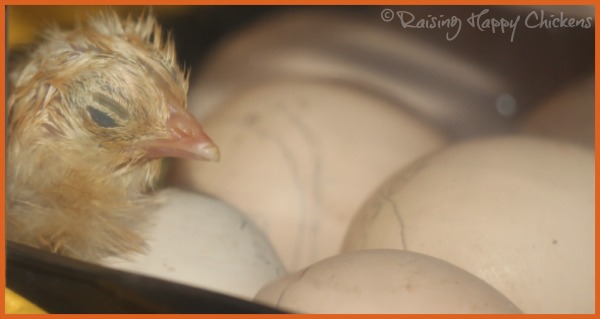
My advice today and tomorrow – and days after that if necessary is don't panic!
Leave your eggs to their own devices. They do know what they're doing.
Related pages.
How to hatch chicken eggs: follow the different stages of incubation and hatching using the button links below.
The first returns to the start of this day-by-day series; the second will take you back to yesterday's information; the third moves on to tomorrow – hatch day!
Other pages about incubating and hatching you may find useful.
Sources.
A lot of "facts" you'll find on the internet are often people's individual views, based on inaccurate information repeated from poor quality sources.
The information I provide in this article and others is based on both my own experience of incubating and hatching chicken eggs every year for over 13 years, but on evidenced facts from scientific, peer-reviewed research and books from highly respected and experienced poultry keepers such as Gail Damerow.
Some of the trusted sources I have used in this article are these.
Avitronics: Heart Rates. Pub. Avian ID, 2020.
Damerow, Gail: Hatching and Brooding Your Own Chicks. Pub. Storey, 2013. See my review, here.
Hamburger, V and Hamilton, H L: A series of normal stages in the development of the chick embryo. Pub. Journal of Morphology, 1951.
Romanini, C.E.B., et al: Monitoring the hatch time of individual chicken embryos. Pub. Journal of Poultry Science, 2013.
Wu et al: Egg fertility and reduced egg fertility, hatching success, and larval survival. Pub. Science Direct, 2003.
Yalcin, W., et al: Incubation Temperature and Lighting: Effect on Embryonic Development, Post-Hatch Growth, and Adaptive Response. Pub. Frontiers in Physiology, 2022.
- Home
- Incubation day by day
- Day 20

